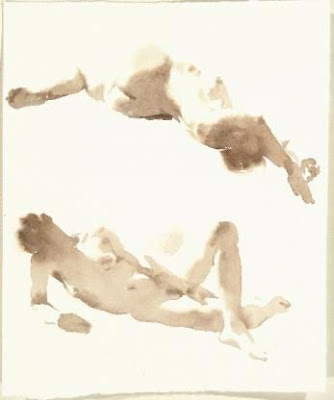This dramatic sky wanted to be painted! It's a little intimidating, though, with all that activity in the sky. Rather than try to duplicate that complex array of marks, I'll look for guidelines that will lead toward an interpretation that feels
similar.
The warm wash across the upper sky portion seems simple enough, but the array of grey brushstrokes requires some analysis. It helps me to ask a few questions the answers to which provide guidelines for approaching the subject in a general way.
What proportion of the sky will become grey?
60%, roughly.
How are the grey strokes distributed?
The majority of the marks are spread across the center of the top half of the page, extending from one side to the other, running right off the page. Mostly clumped together, with a couple apart from the group. Only one or two strokes touch the top of the big shape.
What kind of marks are they? (organic? geometrical? Horizontal? Vertical? Hard? Soft?)
Soft-edged but still distinct, roughly horizontal, irregular and varied.
The answers to these questions are abstract, in that they don't refer to content at all. Theoretically, following them will lead to a passage that reads as a tumultuous sky. It should be possible to turn your back on the scene (or turn the photo over) and still make a convincing version without mentioning the words "sky" or" cloud". Thinking abstractly eliminates the profusion of associations that come along with naming content.
This approach is basically an act of faith. It requires letting go of the usual process where we keep checking to see if we've made sure the viewer will know what they're looking at. The viewers may be hypothetical, but they still deserve respect! Trust that they'll be willing and able to make sense of what you offer, and that they'll appreciate the opportunity to participate in the interpretation.
The following images might seem more approachable if you observe them as pure form and leave content at the door:


























